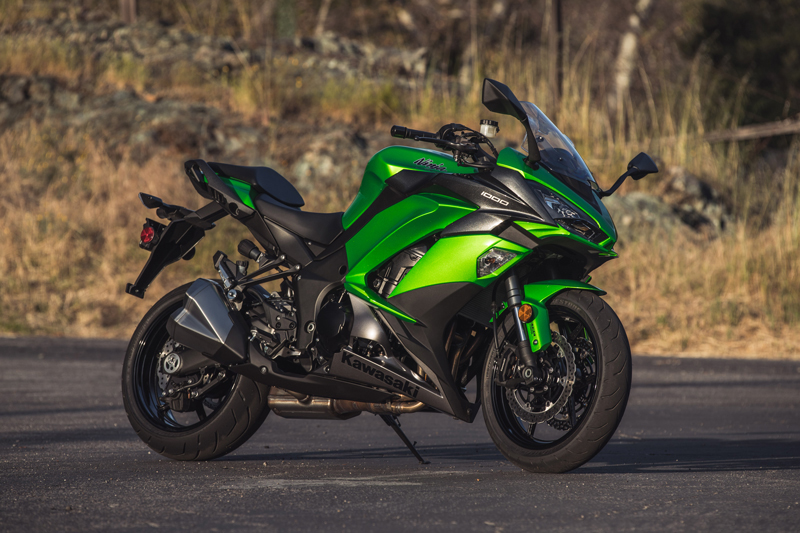2017 Kawasaki Ninja 1000 ABS

First Ride Review
Let’s jump straight to the bottom line: If you’re hooked hard on all the performance advantages offered by liter-class hyper-sportbikes but your body rebels at the pretzel-like contortions necessary to fit on board, the largely revised 2017 Kawasaki Ninja 1000 ABS is your ticket to backroad bliss. Now a sharper tool than ever for active sport use, it retails for only $12,199—a trifling $200 more than the 2016 version. That’s a huge bonus, as are the quick-mount, color-matched 28-liter saddlebags that can be added for $1,164.75—about 100 bucks cheaper than before since no separate mounting brackets are required. So equipped, this is a fun, fun bike that’s ready and willing to slice and dice on your favorite backroads, lug your lunch and laptop to work, or whisk you away for a week-long trip. It all adds up to versatility in spades, on top of awesome sport capabilities.
New bodywork pushes the big Ninja’s visuals deeper into hyper-sport territory for 2017; there’s now a clear-cut connection to the looks of the reigning World Superbike Championship-winning Ninja ZX-10R. However, a few small tweaks improve rider comfort: a slightly taller (up 15mm), three-position-adjustable double-bubble windshield and wider two-piece fairing (up 28mm) help build a surprisingly effective still-air pocket. So riders fully enjoy a seating position that’s distinctly upright, in contrast to the ZX-10R’s forward-crouch track-ready position. The new seat is also wider than last year’s perch for added comfort, and it’s been carefully sculpted to reduce seat height a pinch, from 32.3 inches to 32.1. I’d prefer more padding; extended freeway drones can get you squirming in the seat after 100 miles or so. Kawasaki offers an accessory gel seat that might prove more comfy while offering an identical seat height. In addition, the passenger perch is longer, wider and more padded than before, and it’s shaped to help keep the passenger from sliding forward.
For those already familiar with the previous-generation Ninja 1000’s mechanicals, the basic 1,043cc in-line four engine and rolling chassis with aluminum twin-spar perimeter frame carry over from the bike we last tested in 2014. That’s a positive, not a negative; we previously described the 16-valve engine as “the epitome of silky smooth power, an engine that combines the performance of a sportbike with the civility of a sport tourer.” It remains all that and more. Kawasaki claims that new ECU settings contribute to smoother power delivery and we agree 100 percent. This engine is not only eye-watering strong, it also offers flawless metering from way down low, at 2,000 revs. That quickly builds to tons of midrange torque and a nice cammy rush kicks in at 7,000 rpm and keeps cranking all the way to the 11,000-rpm redline. There’s abundant power all the time, so much so that we kept searching for seventh gear—not because the engine is busy, but because there’s so much pull down low you automatically think it’s time to kick it up a cog. The gearbox is delightful in action, and an assist/slipper clutch makes for a wonderfully light clutch pull.
The previous model came equipped with 3-mode KTRC traction control and dual power modes, but now Kawasaki adds even more race-style ZX-10R electronics technology to the Ninja 1000. A new 6-axis Bosch Inertial Measurement Unit (IMU) bestows Kawasaki Cornering Management Function (KCMF) and Kawasaki Intelligent anti-lock Brake System (KIBS) capabilities. KCMF monitors engine and chassis parameters while cornering, modulating braking force and engine power to facilitate smooth transitions from acceleration to braking and back again, which helps the rider maintain the intended line through the corner. KIBS also monitors multiple systems—wheel sensors, front caliper hydraulic pressure, throttle position, engine speed, clutch actuation and gear position—to provide the best braking action possible under dynamic conditions. We tried all the different settings and in the end we just left things at full power and the KTRC 1 setting since it all works seamlessly together. Because the fuel metering is so precise and the driveline lash so well controlled, we didn’t feel a need to use reduced power settings even when rain showers turned roads slick.
In dry weather, the Ninja 1000 is a hoot and a half on twisty canyon roads. Its 56.7-inch wheelbase is actually a touch shorter than that of the ZX-10R, and at 24.5 degrees its steering rake is a half-degree steeper than the 10R’s. So despite carrying about 60 pounds more weight, the Ninja 1000 feels plenty sporty in real-world use. Crisp, responsive and intuitive steering let the bike dance down backroads; you charge through corners effortlessly as the bike seemingly reads your thoughts. And the conventional, adjustable suspension components front and rear function very well, for reasonable cost. The brakes provide plenty of strong, linear stopping action and excellent feel.
The few complaints we can muster are only minor, showing up on extended highway stints. We’d like more seat padding (easily fixed), a slightly taller windscreen to keep bugs off our face shield, and a cruise control for more relaxing long-range use. Otherwise, the 2017 Ninja 1000 is simply as good as it gets for a no-fooling sportbike with comfortable ergonomics, long legs and an affordable price tag.
